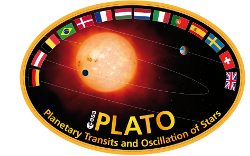Latest news
-
Tuesday, 9 June, 2020POSTER: Hunting terrestrial exoplanets with PLATO 2.0 Mission. PLATO 2.0 (PLAnetary Transits and Oscillation of stars) is the M3 class mission of the ESA. Its goal is detecting and charaterizing terrestrial exoplanets in the habitable zone of sun-like start.
-
Tuesday, 19 May, 2020Science Highlights 2019
-
Thursday, 6 June, 2019Los primeros datos del satélite TESS arrojan luz sobre las estrellas roAp, las pulsantes extremas
-
Thursday, 7 February, 2019European Science Cluster of Astronomy & Particle physics ESFRI research infrastructures (ESCAPE) has received funding from the European Commission Framework Programme Horizon 2020 Research and Innovation action under grant agreement n. 84064. H2020-ESCAPE aims to address the Open Science challenges shared by ESFRI facilities (CTA, ELT, EST, FAIR, HL-LHC, KM3NeT, SKA) as well as other pan-European research infrastructures (CERN, ESO, JIV-ERIC, EGO-Virgo) in astronomy and particle physics research domains. The official project launch date is 1 February 2019. The project has a runtime of 42 months and it will be coordinated by CNRS-LAPP, Annecy. In view of the project launch, CNRS-LAPP, the coordinator of the H2020-ESCAPE project is pleased to invite all the project partners to the ESCAPE Kick-off meeting in Annecy, France from 7-8 February 2019. This two day meeting will be an opportunity for all the 31 European project partners to present the planned workpackage activities as well as discuss the project plan.
-
Monday, 3 December, 2018The main objective of this workshop is to bring together people from the exoplanet and stellar communities working on this topic, with particular emphasis on the work to be done in the context of the ESA PLATO mission. The limb-darling parameter is nowadays an essential ingredient in stellar and planetary studies, hence the importance of this dedicated WP for the scientific preparation and future exploitation of the PLATO space mission. This parameter is frequently found during the exoplanetary transits’ fitting process. In this workshop we will discuss about alternative methods to determine the limb-darkening that help us to validate the values obtained. Moreover, precise knowledge of limb-darkening is also crucial for the accurate determination of interferometric radius of the stars hosting planets. This raises some open questions that will discussed in the workshop, like, the precision/accuracty of the limb-darkening parameter, the nature of the limb-darkening used, or the impact on the uncertainty in the stellar radius and thereby in the planet radius.
-
Monday, 16 July, 2018The Spanish Astronomical Society (SEA) will celebrate its XIII Biannual Meeting in the city of Salamanca from 16th to 20th July 2018. Our conference will be held in the famous Hospedería del Colegio Arzobispo Fonseca, as one of the acts belonging to the 800th anniversary of the University of Salamanca. As usual, the base idea supporting this event is to create a scientific discussion forum where the Spanish astronomical community and its guests could present and debate its latest results, promote new collaborations and prepare themselves to face future challenges. We believe this conference should be a meeting point where every astronomer has a say and where our young members could advance in their research career. The meeting’s format is divided in plenary and parallel sessions, whose topics are of the interest of our community. We would like to emphasize that, for the first time, there will be a plenary session on the communication and teaching of Astronomy. Moreover, because not only the geographic closeness but also our strong cultural links, the invited country for the present edition is Portugal. We expect to host a large number of our fellow Portuguese astronomers in order to increase the already existent collaborations and also to hopefully starting new ones.
-
Wednesday, 16 May, 2018Part of the PLATO Granada Team has been invited to take part in PLATO community data analysis exercise.
-
Thursday, 8 February, 2018Nueva sección sobre los congresos más importantes del año.
-
Tuesday, 5 December, 2017Summarize the work done in studying the direct deconvolution method: in section one, the theory behind this method is presented; in section two, the results of different tests done with the method that have been obtained; in section three, the conclusions that are drawn from these tests; and in section four, some open issues still waiting for interpretation together with upcoming results of new analysis.
-
Tuesday, 6 June, 2017Time and Measurement Workshop
